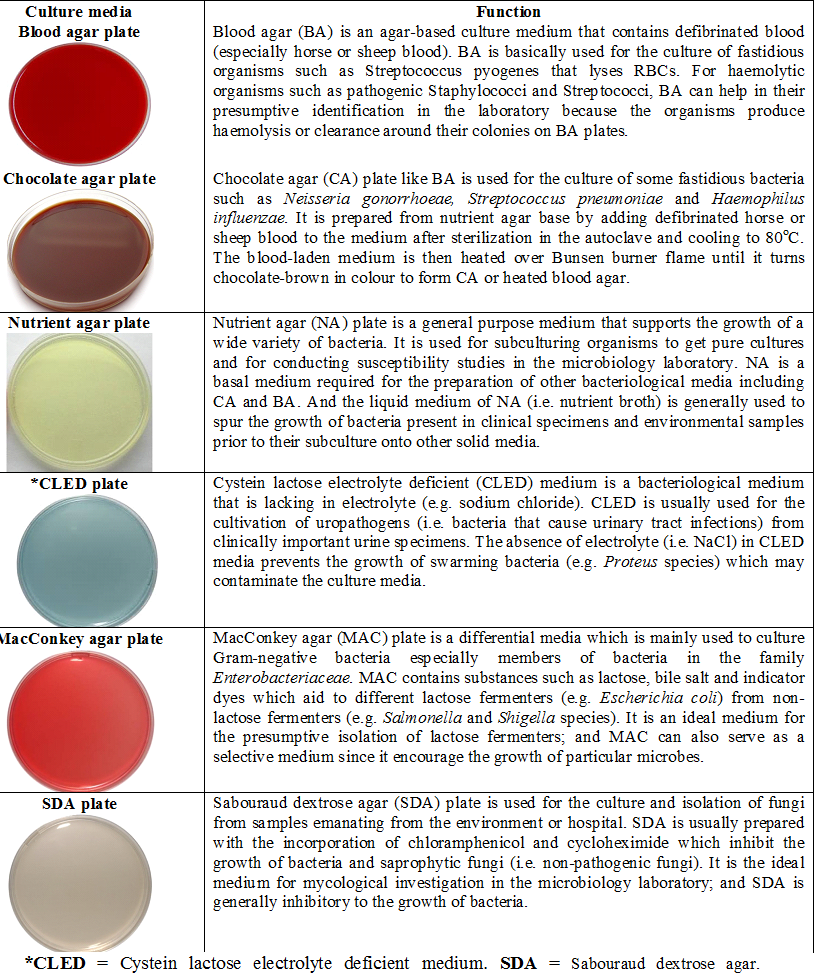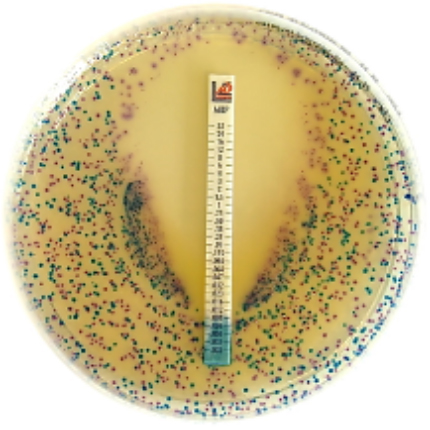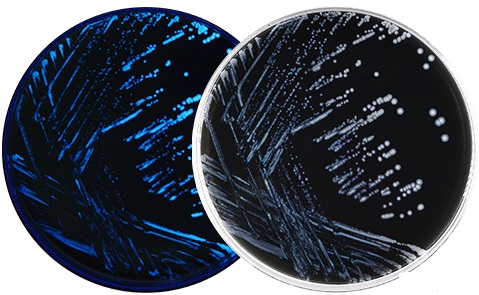The clinical diagnosis of some infectious diseases (including those caused by bacteria and fungi) in the microbiology laboratory is mainly based on the isolation and cultivation of pathogenic organisms; and this is usually done in vitro with the aid of specialized culture or growth media that supports the growth of microbes outside their usual habitat. Apart from playing significant role in identifying the causative agent of a particular disease, microbial culture also gives the microbiologist a clue of the organism’s colonial morphology and other phenotypic characteristics that aids in its identification and characterization.
It is noteworthy that obligate intracellular microbes (e.g. viruses, Chlamydia and Rickettsia) that mainly live within the host cell cannot be isolated and cultured on solid bacteriological media (as is the case for fungi and bacteria); instead strict intracellular microorganisms can only be isolated and cultured in the presence of living cells in techniques known as cell culture. The history of bacteriological culture media dates back to the days of Robert Koch when agar (a solidifying agent) was discovered and used to solidify culture media.
Before the discovery of agar by Fanny Eilshemius (the wife of Walter Hesse, an assistant to Robert Koch), several solidifying agents including gelatin and potato pieces where used to solidify nutrient media but these method proved unsuccessful as they were not as successful as agar-agar which is universally used after its discovery in 1881 by Fanny Eilshemius as a base for many microbiological solid media.
Agar gels at moderate temperatures (e.g. 40-50oC) after heating. However, at high temperatures (e.g. 100oC and above) agar liquefies but solidifies again when it is cooled to temperatures of 50oC. Broth or liquid media does not contain agar or agar-agar, and thus they do not solidify.
However, semi-solid media such as Amies transport media contain minimal amount of agar; and thus the consistency of such culture medium are partially solid, and they are neither solid nor liquid in form. Culture media required for microbiological investigations (especially for bacteriological and mycological experimentations) are basically classified into three different categories according to some criterion as follows:
- Classification according to consistency.
- Classification according to nutritional components.
- Classification according to function or property.
Based on consistency, culture media can be classified as solid culture media, semi-solid culture media and liquid culture media or broth. Whilesolid culture media contain agar or agar-agar that makes it to be solidified, semi-solid culture media contain a reduced amount of agar and are thus partially solidified (i.e. they are not completely solidified). Liquid culture media otherwise known as broth do not contain agar (the solidifying agent), and as such they do not solidify but remain as fluid.
According to their nutritional components, culture media can be classified as either complex media or synthetic media. Complex culture media are media that contain unknown amounts of some nutrients; and they are mainly used for the cultivation of fastidious bacteria (i.e. bacteria that require additional growth nutrients such as blood or serum for growth). Also known as undefined media, complex media are generally known as culture media in which the precise chemical constituents of the media are not known.
They contain some composite substances such as blood, yeast, and meat extract whose exact chemical makeup is uncertain. They comprise of some routinely used culture media in the microbiology laboratory such as blood agar, chocolate agar, MacConkey agar, and tryptone soya broth amongst others. Complex culture media are routinely used in microbiology laboratory for the growth of pathogenic bacteria especially those that are fastidious in nature.
Synthetic culture media are culture media whose nutrient constituents are known. They can also be called defined culture media or chemically-defined media because their nutrient components are known at their exact chemical constituents; and synthetic media are usually compounded or developed from the scratch by the researcher or student by mixing certain amounts of different materials or substances that encourage the growth of certain type of bacteria. Synthetic culture media are generally used to study different physiological states of some microorganisms such as when evaluating the minimal nutritional requirements of microbial cells.
Based on their function or property, culture media can be classified into several groups and this include: selective media, differential or indicator media, general purpose or basal media, enriched media, enrichment media, composite media, storage media and transport culture media.
Agar or agar-agar is unique, and an incomparable ingredient of solid media because of its solidifying properties which makes it an excellent constituent of solid media used for various bacteriological and mycological applications in the microbiology laboratory.
Some of the important characteristics of agar as a solidifying agent used for the preparation of culture/growth media are as follows:
- Agar is physiologically stable upon usage and storage.
- Agar is nontoxic to the growth of bacteria, and thus it does not kill the microbe when mixed with it.
- It solidifies at about 50oC and melts at 100oC.
- Agar is stable during sterilization.
- Agar is not easily degraded by most pathogenic microorganisms.
- Agar plates provide the best medium for isolating pure cultures of bacteria from mixed ones.
Culture media (singular: medium) are nutrient medium or preparations that supports and allow microorganisms to be propagated in the laboratory for further study. They are artificial growth medium that support the growth of microbes outside their natural host or environment. Culture media provide all necessary nutrients and growth factors that encourage the development of the organism inoculated in it.
Microorganisms are usually introduced into the culture media (which can be solid, liquid or semi-solid) through a process known as inoculation, and the inoculated plates or medium are incubated at optimum temperature and later observed for microbial growth known as culture. A culture in microbiology refers to colonies of microorganisms (bacteria in particular) that grow and multiplies in or on a culture medium.
Artificial microbiological culture media provide all the essential environmental and nutritional requirement of the organism(s) to be culture because virtually all pathogenic microorganisms and some commensals are chemoorganoheterotrophic in their mode of nutrition and rarely produce their own food. Peptone, yeast extract, meat extract, water and agar re some of the main constituents of most microbiological artificial culture media. There are several culture media available for the propagation of microorganisms as well as for the transportation and storage of microbes in the microbiology laboratory.
The choice of which type of culture media to use is often influenced by many factors including but not limited to the nutritional requirement of the microorganism, the natural habitat of the microbe and on the experience or particular need of the scientists. Microbiological culture media especially those for bacteriological and mycological studies are classified into different categories. Table 1 shows some of the basic culture media commonly used for various bacteriological and mycological investigations in the microbiology laboratory.
Table 1. Illustration of some microbiological culture media

REFERENCES
Atlas R.M (2010). Handbook of Microbiological Media. Fourth edition. American Society of Microbiology Press, USA.
Balows A, Hausler W, Herrmann K.L, Isenberg H.D and Shadomy H.J (1991). Manual of clinical microbiology. 5th ed. American Society of Microbiology Press, USA.
Basic laboratory procedures in clinical bacteriology. World Health Organization (WHO), 1991. Available from WHO publications, 1211 Geneva, 27-Switzerland.
Black, J.G. (2008). Microbiology: Principles and Explorations (7th ed.). Hoboken, NJ: J. Wiley & Sons.
Garcia L.S (2010). Clinical Microbiology Procedures Handbook. Third edition. American Society of Microbiology Press, USA.
Garcia L.S (2014). Clinical Laboratory Management. First edition. American Society of Microbiology Press, USA.
Ira R (1995). Bacteriology, Standard Operative procedure manual for microbiology laboratories, National Institute of Biologicals. Pp. 73-97.
Madigan M.T., Martinko J.M., Dunlap P.V and Clark D.P (2009). Brock Biology of Microorganisms, 12th edition. Pearson Benjamin Cummings Inc, USA.
Woods GL and Washington JA (1995). The Clinician and the Microbiology Laboratory. Mandell GL, Bennett JE, Dolin R (eds): Principles and Practice of Infectious Diseases. 4th ed. Churchill Livingstone, New York.
Discover more from #1 Microbiology Resource Hub
Subscribe to get the latest posts to your email.



